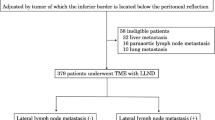Abstract
PURPOSE: Although the existence of lateral lymphatic drainage of the rectum has been verified anatomically, the clinical importance of it has not yet been fully investigated. The lack of a definition of lateral lymphatic flow makes it difficult to analyze and compare data. The aim of this study was to define the concept of lateral lymphatic drainage and explore its relationship to total mesorectal excision and to disclose the incidence and efficacy of dissection of lateral node involvement. METHODS: Review of anatomic and clinical research on lateral lymphatic flow was made to create a definition of lateral lymphatic flow. Based on this review, a three-space dissection was designed and applied. A retrospective analysis was made of 764 patients with rectal cancer treated by a curative three-space dissection operation during 20 years starting in 1975 at Cancer Institute Hospital. RESULTS: Lateral lymphatic flow passes from the lower rectum and through the lateral ligament laterally beyond the mesorectum. It then ascends along the internal iliac artery and, in addition, inside the obturator space. Sixty-six cases proved to have lateral node involvement, which comprised 8.6 percent of all rectal cancer and 16.4 percent of low-lying (lower margin below 5 cm above the dentate line) rectal cancer cases. The five-year survival rate of these 66 cases was 42.4 percent. There were 16 cases that had a solo lateral node involvement. CONCLUSION: Lateral lymphatic flow from low-lying rectal cancer passes outside the boundaries of total mesorectal excision but within the range of curative surgery by three-space dissection.
Similar content being viewed by others
References
Gerota D. Die Lymphgefaesse des Rectums und Anus. Arch Anat Physiol, Anat Abt 1895;240–56.
Poirier P, Cuneo B, Delamere G. The lymphatics. Chicago: WT Keener, 1904.
Villemin F, Haurd P, Montagne M. Recherches anatomiques sur les lymphatiques du rectum et de l'anus. Rev Chir 1925;63:39–80.
Sauer I, Bacon HE. A new approach for excision of carcinoma of the lower portion of the rectum and anal canal. SGO 1952;95:229–42.
Bacon HE. Cancer of the colon, rectum and anal canal. Philadelphia: JB Lippincott, 1964.
Stearns MW Jr, Deddish MR. Five-year results of abdominopelvic lymph node dissection for carcinoma of the rectum. Dis Colon Rectum 1959;2:169–72.
Blair JB, Holyoke DA, Best RR. A note on the lymphatics of the middle and lower rectum and anus. Anat Rec 1950;108:635–44.
Senba Y. An anatomical study of lymphatic system of the rectum [in Japanese]. J Hukuoka Med Coll 1927;20:1213–68.
Heald RJ, Husband EM, Ryall RD. The mesorectum in rectal cancer surgery—the clue to pelvic recurrence? Br J Surg 1982;69:613–6.
Heald RJ. The “holy plane” of rectal surgery. J R Soc Med 1988;81:503–8.
Tobin CE, Benjamin JA, Wells JC. Continuity of the fasciae lining the abdomen, pelvis, and spermatic cord. SGO 1946;83:575–96.
Robert WH, Habenicht J, Krishingner G. The pelvic and perineal fasciae and their neural and vascular relationship. Anat Rec 1964;49:707–20.
Uhlenhuth E. Problems in the anatomy of the pelvis. Philadelphia: JB Lippincott, 1953.
Miles WE. A method of performing abdominoperineal excision for carcinoma of the rectum and of the terminal portion of the pelvic colon. Lancet 1908;2:1812–4.
Dixon CF. Surgical removal of lesions occurring in the sigmoid and rectosigmoid. Am J Surg 1939;46:12–7.
Miles WE. Cancer of the rectum. London: Harrison & sons, 1926.
Glass RE, Ritchie JK, Thompson HR, Mann CV. The results of surgical treatment of cancer of the rectum by radical resection and extended abdomino-iliac lymphadenectomy. Br J Surg 1985;72:599–601.
McArdle CS, Hole D. Impact of variability among surgeons on post operative morbidity and mortality and ultimate survival. Br Med J 1991;302:1501–5.
Minsky BD, Mies C, Recht A, Rich TA, Chaffey JT. Resectable adenocarcinoma of the rectosigmoid and rectum. Patterns of failure and survival. Cancer 1988;61:1408–16.
Quirke P, Durdey P, Dixion MF, Williams NS. Local recurrence of rectal adenocarcinoma due to inadequate surgical resection: histopathological study of lateral tumour spread and surgical excision. Lancet 1986;2:996–8.
Lee JF, Maurer VM, Block GE. Anatomic relations of pelvic autonomic nerves to pelvic operations. Arch. Surg 1973;107:324–8.
Enker WE, Laffer UT, Block GE. Enhanced survival of patients with colon and rectal cancer is based upon wide anatomic resection. Ann Surg 1979;190:350–60.
Kuru M. Cancer of the rectum [in Japanese]. J Jpn Surg Soc 1940;41:832–77.
MacFarlane JK, Ryall RD, Heald RJ. Mesorectal excision for rectal cancer. Lancet 1993;341:456–60.
Heald RJ, Moran BJ, Ryall RD, Sexton R, MacFarlane JK. Rectal cancer. Arch Surg 1998;133:894–9.
Heald RJ, Smedh RK, Kald A, Sexton R, Moran BJ. Abdominoperineal excision of the rectum—an endangered operation. Dis Colon Rectum 1997;40:747–51.
Enker WE, Thaler HT, Cranor ML, Polyak T. Total mesorectal excision in the operative treatment of carcinoma of the rectum. J Am Coll Surg 1995;181:335–46.
Enker WE, Havenga K, Polyak T, Thaler H, Cranor M. Abdomino- perineal resection via total mesorectal excision and autonomic nerve preservation for low rectal cancer. World J Surg 1997;21:715–20.
MacFarlane JK. Lateral node dissection—a clitique. In: Soreide O, Norstein J, eds. Rectal cancer surgery. Berlin: Springer-Verlag, 1997.
Cohen AM. Adjuvant therapy in rectal cancer. Hepatogastroenterology 1992;39:215–21.
Gerad AM, Buyse B, Nordlinger J,et al. Preoperative radiotherapy as adjuvant treatment in rectal cancer. Ann Surg 1988;208:606–14.
Habr-Gama A, de Souza PM, Ribeiro U Jr,et al. Low rectal cancer: impact of radiation and chemotherapy on surgical treatment. Dis Colon Rectum 1998;41:1087–96.
Enker WE. Potency, cure, and local control in the operative treatment of rectal cancer. Arch Surg 1992;127:1396–402.
Takahashi T, Ueno M, Azekura K, Ota H. The lymphatic spread of rectal cancer and the effect of dissection: Japanese contribution and experience. In: Soreide O, Norstein J, eds. Rectal cancer surgery. Berlin: Springer-Verlag, 1997.
Author information
Authors and Affiliations
About this article
Cite this article
Takahashi, T., Ueno, M., Azekura, K. et al. Lateral node dissection and total mesorectal excision for rectal cancer. Dis Colon Rectum 43 (Suppl 10), S59–S68 (2000). https://doi.org/10.1007/BF02237228
Issue Date:
DOI: https://doi.org/10.1007/BF02237228




